Deza M.M., Laurent M. Geometry of Cuts and Metrics
Подождите немного. Документ загружается.

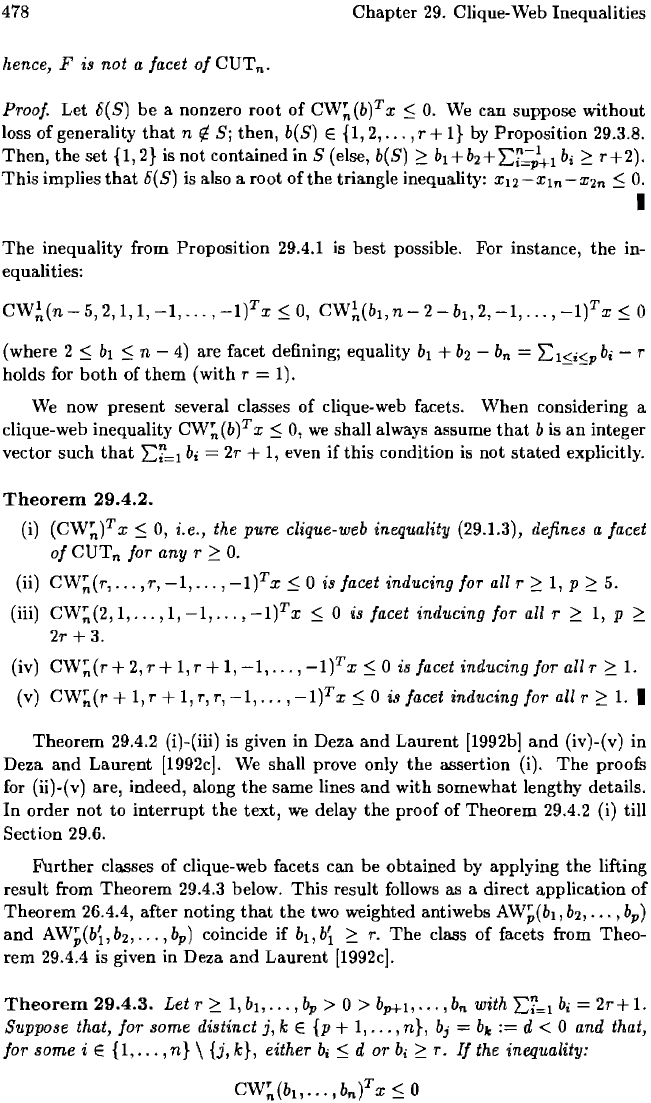
478
Chapter
29.
Clique-Web Inequalities
hence, F is
not
a Jacet
oj
CUT
n
.
ProoJ. Let 6(8) be a nonzero root
of
CW~(b)T
x
~
O.
We
can
suppose without
loss
of
generality
that
n
I/:
8;
then, b(8) E {I,
2,
...
,r
+ I}
by
Proposition 29.3.8.
Then,
the
set
{I,
2}
is not contained in 8 (else, b(8)
2:
b
i
+b
2
+
L~~+1
b
i
2:
T+2).
This
implies
that
6(8) is also a root
of
the
triangle inequality: XI2-Xln
-X2n
~
O.
I
The
inequality from Proposition 29.4.1 is best possible. For instance,
the
in-
equalities:
CW~(n
- 5,
2,
I,
1,
-1,
...
,
_1)T
x
~
0,
CW~(bl,n
2 -
bb
2,
-1,
...
,
-If
x::; 0
(where 2
::;
bi
::;
n -
4)
are facet defining; equality b
i
+
b2
- b
n
=
Lisispb;
- T
holds for
both
of
them
(with T = 1).
We
now present several classes of clique-web facets.
When
considering a
clique-web inequality
CW~(bf
x::; 0,
we
shall always assume
that
b is
an
integer
vector such
that
L~==I
bi
=
2T
+
1,
even if
this
condition is not
stated
explicitly.
Theorem
29.4.2.
(i)
(CW~)T
x
::;
0, i.e., the
pUTe
clique-web inequality (29.1.3), defines a Jacet
oj
CUTn
JOT
any T
2:
O.
(ii)
CW~(T,
...
,T,
-1,
...
,
_1)T
X
~
0 is Jacet inducing
JOT
all T
2:
1, p
2:
5.
(iii)
CW~
(2,
1,
...
,1,
-1,
...
,
_1)T
x
~
0 is Jacet inducing
JOT
all T
2:
1,
p
2:
2T
+ 3.
(iv)
CW~(r+2,T+
l,r+
1,-1,
...
,
-1)Tx::;
0 is Jacet inducing Jor all r
2:
1.
(v)
CW~(r
+
I,
r + 1, r, r,
-1,
...
,
_1)T
x
~
0 is Jacet inducing Jor all r
2:
1.
I
Theorem 29.4.2 (i)-(iii) is given in Deza
and
Laurent
[1992b]
and
(iv)-(v) in
Deza
and
Laurent
[1992c].
We
shall prove only the assertion (i).
The
proofs
for
(ii)-( v) are, indeed, along
the
same lines and with somewhat lengthy details.
In
order
not
to
interrupt
the
text,
we
delay
the
proof of Theorem 29.4.2 (i) till
Section 29.6.
Further
classes of clique-web facets can be obtained by applying
the
lifting
result from Theorem 29.4.3 below.
This
result follows as a direct application of
Theorem 26.4.4, after noting
that
the
two weighted antiwebs AW;(b
J
,
b2,
•..
, b
p
)
and
AW;(bi,b2,
...
,b
p
)
coincide if
bl,bi
2:
r.
The
class
of
facets from Theo-
rem 29.4.4 is given in Deza
and
Laurent [1992c].
Theorem
29.4.3.
Let
r
2:
1,
b
I
,
...
, b
p
> 0 >
bp+I,''''
b
n
with
Li'==1
bi
=
2r+
L
Suppose that,
JOT
some distinct
j,
k E {p + 1,
...
,
n},
bj =
b",
:=
d < 0 and that,
Jor
some
i E
{I,
...
,
n}
\ {j,
k},
either b
i
::;
d
OT
b
i
2:
r.
IJ the inequality:
CW~(bl,
...
, bn)T x::; 0
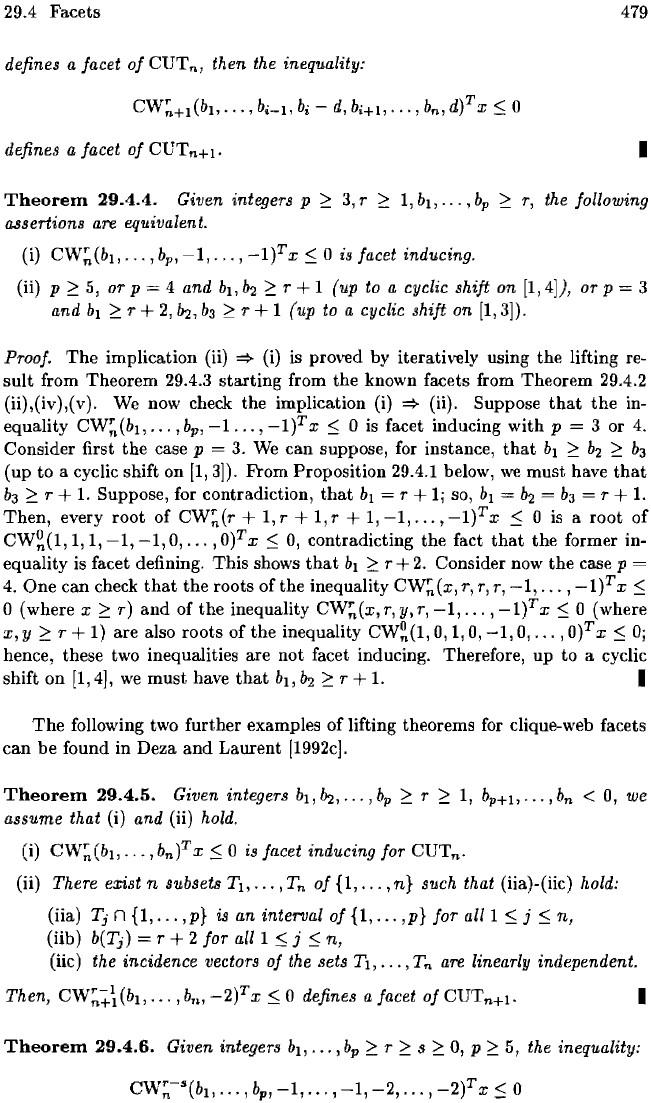
29.4 Facets
479
defines a Jacet
oj
CUT
n
,
then the inequality:
defines a Jacet
oj
CUT
n
+1'
I
Theorem
29.4.4.
Given integers p
;:::
3,
r
;:::
1,
b
I
,
...
,b
p
;:::
r, the Jollowing
assertions are equivalent.
(i)
CW~(bI"'"
b
p
,
-1,
...
,
_l)T
x::; ° is Jacet inducing.
(ii) p
;:::
5,
or
p 4 and b},
~
;:::
r + 1 (up to a cyclic
shift
on
[1,4]),
or
p = 3
and
bI
;:::
r +
2,~,
b3
;:::
r + 1 (up to a cyclic shift on [1,3]).
ProoJ.
The
implication (ti)
~
(i) is proved by iteratively using
the
lifting re-
sult
from Theorem 29.4.3 starting from
the
known facets from Theorem 29.4.2
(ii),(iv),(v). We now check the implication (i)
~
(ii). Suppose
that
the
in-
equality
CW~(b},
...
, b
p
,
-1
...
,
-1)T
X
::;
° is facet inducing with p = 3 or
4.
Consider first the case p =
3.
We
can suppose, for instance,
that
b
I
;:::
b
2
;:::
b3
(up to a cyclic shift on [1,3]). From Proposition 29.4.1 below,
we
must have
that
b3
;:::
r + 1. Suppose, for contradiction,
that
b
I
= r +
1;
so, b
I
= ~ = b
3
= r +
l.
Then,
every root
of
CW~(r
+
1,
r +
1,
r +
1,
-1,
...
,
_1)T
x
::;
°
is
a root
of
CW~(I,
1,
1,
-1,
-1,0,
...
,
O)T
X
::;
0,
contradicting the fact
that
the
former in-
equality
is
facet defining. This shows
that
b
I
;:::
r +
2.
Consider now
the
case p
4.
One can check
that
the roots
ofthe
inequality
CW~(x,
r, r, r,
-1,
...
,_I)T
x::;
° (where x
;:::
r)
and of the inequality
CW~
(x, r, y, r,
-1,
...
,
_I)T
x
::;
° (where
x,y
;:::
r + 1) are also roots
of
the inequality
CW~(I,O,
1,0,
-1,0,
...
,O)T
x::;
OJ
hence, these two inequalities are not facet inducing. Therefore, up
to
a cyclic
shift on [1,4J,
we
must have
that
b
I
,
~
;:::
r + 1. I
The
following two further examples of lifting theorems for clique-web facets
can be found in Deza and Laurent
[1992cJ.
Theorem
29.4.5.
Given integers
bI,~,
...
,bp;:::
r;:::
1,
b
p
+1,
...
,b
n
< 0, we
assume
that (i) and (ii) hold.
(i)
CW~(b},
...
, bn)T x::; ° is Jacet inducing Jor
CUT
n
•
(ii) There exist n subsets T},
...
, Tn
oj
{I,
...
,n}
such that (iia)-(iic) hold:
(iia) T
j
n {I,
...
,p}
is an interval
oj
{I,
...
,p}
Jor
alII::;
j::;
n,
(lib)
b(Tj)
= r + 2 Jor
aliI::;
j
::;
n,
(tic) the incidence vectors
oj
the sets T
I
,
•..
, Tn
are
linearly independent.
Then,
CW~+HbI,
...
,bn,-2)TX::;
° defines a Jacet
oJCUT
n
+
I
.
I
Theorem
29.4.6.
Given integers b
I
,
...
, b
p
;:::
r
;:::
s
;:::
0, p
;:::
5, the inequality:
...
,
-1,
-2,
...
,
-2f
x::;
°
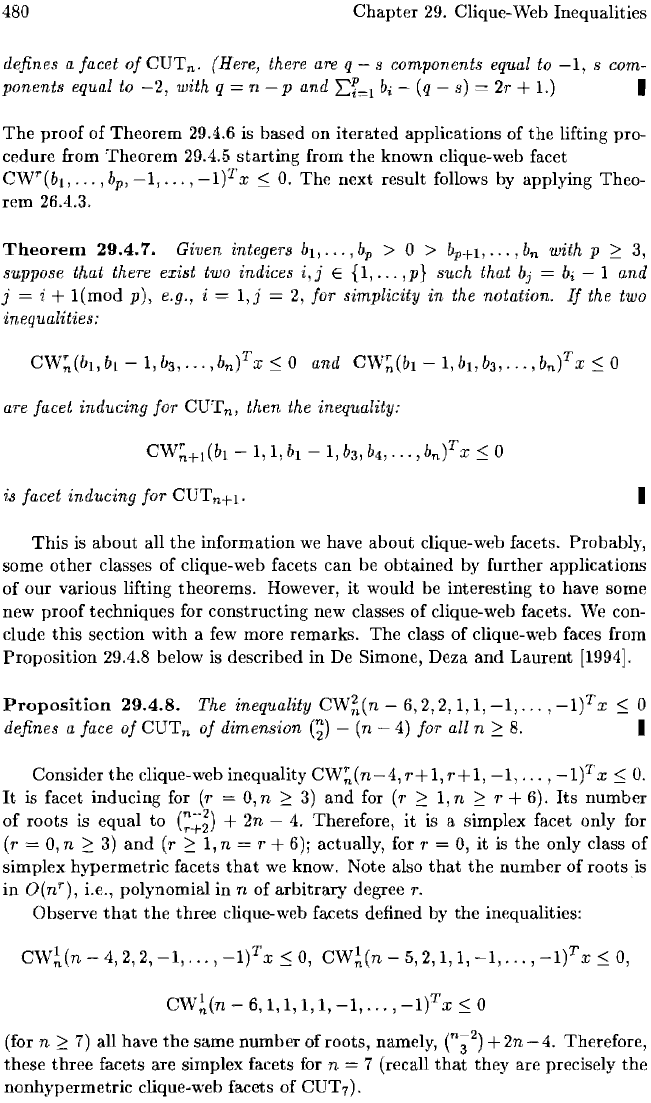
480
Chapter
29.
Clique-Web Inequalities
defines a facet
of
CUT
n
.
(Here, there
are
ponents equal to
-2,
with q n p and
- s components equal to
-1,
s com-
b;
-
(q
s)
2r + 1.) I
The
proof
of
Theorem 29.4.6 is based on
iterated
applications of
the
lifting pro-
cedure from
Theorem
29.4.5
starting
from
the
known clique-web facet
CW
T
(bl,
...
,b
p
,-I,
...
,
::;
O.
The
next result follows by applying Theo-
rem
26.'1.3.
Theorem
29.4.7.
Given integers b
i
,
...
, b
p
> 0 >
bp+l,""
b
n
with p
2:
3,
suppose that there exist two indices
i,j
E
{I,
...
,p}
such that
bj
= b
i
-
1 and
j i +
l(mod
p), e.g., i
l,j
2, for simplicity
in
the notation.
If
the two
inequalities:
are facet inducing for
CUT
n
,
then the inequality:
i,s
facet inducing for
CUTn+l'
I
This
is
about
all
the
information
we
have
about
clique-web facets. Probably,
some
other
classes of clique-web facets can be obtained by further applications
of
our
various lifting theorems. However,
it
would be interesting
to
have some
new
proof
techniques for constructing new classes of clique-web facets.
\Ve
con-
clude
this
section with a
few
more remarks.
The
class
of
clique-web faces from
Proposition
29.4.8 below is described in De Simone, Deza
and
Laurent [1994].
Proposition
29.4.8.
The inequality
CW;(n
-
6,2,2,1,1,
-1,
...
,
defines a face
of
CUTn
of
dimension
G)
- (n
4)
for all n
2:
8.
o
I
Consider
the
clique-web inequality
CW~(n-4,
r+
1,
r+
I,
-1,
...
,
::;
0.
It
is facet inducing for
(r
0, n
2:
3)
and
for
(r
2:
1,
n
2:
r + 6).
Its
number
of
roots
is equal
to
(;~;)
+ 2n
4.
Therefore,
it
is
a simplex facet only for
(r = 0, n
2:
3)
and
(r
2:
1, n = r + 6); actually, for r 0,
it
is
the
only class of
simplex hypermetric facets
that
we
know. Note also
that
the
number
of roots
is
in
O(nT), i.e., polynomial in n of
arbitrary
degree r.
Observe
that
the
three
clique-web facets defined by
the
inequalities:
CW;'(n
-
4,2,2,
...
;
::;
0,
CW;'(n
5,2,1,1,
...
,-I)T
X
::;O,
CW;'(n
6,1,1,1,1,-1,
...
, ::;0
(for
n
2:
7)
all have
the
same
number
of
roots, namely,
(n;-2)
+ 2n -
4.
Therefore,
these
three
facets are simplex facets for n = 7 (recall
that
they
are precisely
the
nonhypermetric clique-web facets
of
CUT
7
).
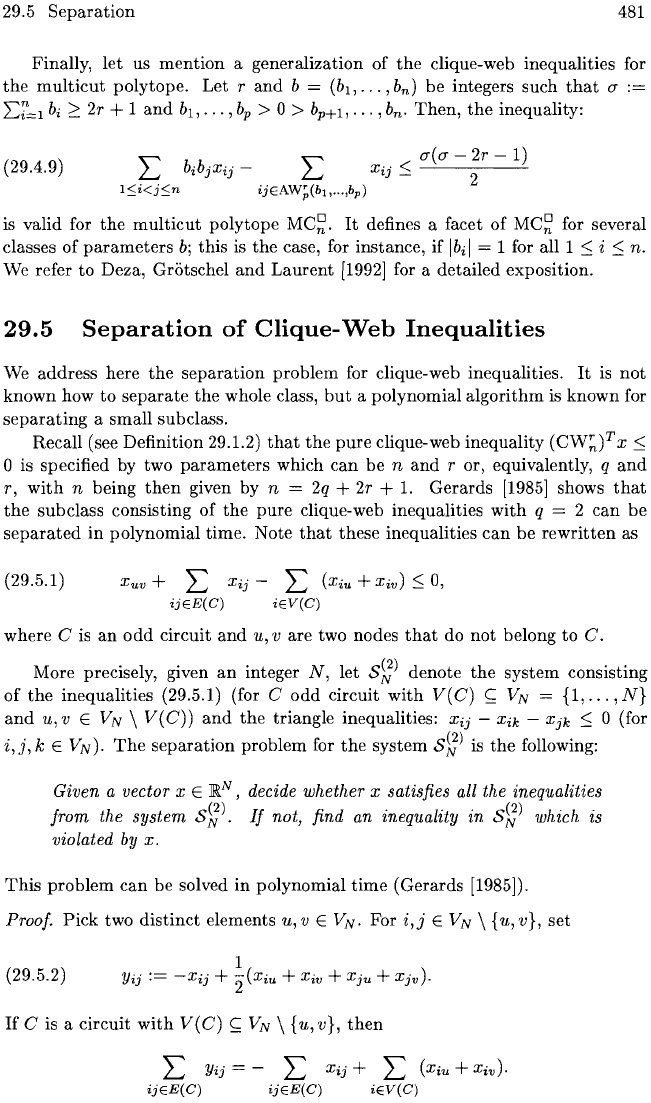
29.5
Separation
481
Finally, let us
mention
a generalization of
the
clique-web inequalities for
the
multicut
polytope. Let
rand
b =
(b
1
,
•••
, b
n
)
be integers such
that
(J
.-
L~=l
b
i
::::
2r + 1
and
b
1
,
...
, b
p
> 0 > b
p
+1,
.
..
,b
n
.
Then,
the
inequality:
(29.4.9)
is
valid for
the
multicut
polytope
MC~.
It
defines a facet
of
MC~
for several
classes of
parameters
b;
this
is
the
case, for instance, if
Ibil
= 1 for
alII
~
i
~
n.
We refer to Deza, Grotschel
and
Laurent
[1992]
for a detailed exposition.
29.5
Separation
of
Clique-Web
Inequalities
We address here
the
separation
problem for clique-web inequalities.
It
is
not
known how
to
separate
the
whole class,
but
a polynomial
algorithm
is
known for
separating
a
small
subclass.
Recall (see Definition 29.1.2)
that
the
pure
clique-web inequality
(CW~f
x
~
o is specified by two
parameters
which
can
be
nand
r or, equivalently, q
and
r,
with
n being
then
given by n = 2q + 2r +
1.
Gerards
[1985]
shows
that
the
subclass consisting
of
the
pure
clique-web inequalities
with
q = 2
can
be
separated
in
polynomial
time. Note
that
these inequalities
can
be
rewritten
as
(29.5.1)
Xuv
+ L
Xij
- L
(Xiu
+
Xiv)
~
0,
ijEE(C)
iEV(C)
where C
is
an
odd
circuit
and
u,
v are two nodes
that
do
not
belong to
C.
More precisely, given
an
integer
N,
let
S~)
denote
the
system
consisting
of
the
inequalities (29.5.1) (for C
odd
circuit
with
V(C)
~
VN
=
{I,
...
,
N}
and
u,v
E
VN
\
V(C))
and
the
triangle inequalities:
Xij
-
Xik
-
Xjk
~
0 (for
i,j,
k E VN).
The
separation
problem for
the
system
S~)
is
the
following:
Given a vector x E
jRN,
decide whether x satisfies all the inequalities
from the
system
S~).
If
not, find an inequality
in
S~)
which is
violated by
x.
This
problem
can
be solved
in
polynomial
time
(Gerards [1985]).
Proof.
Pick
two
distinct
elements
u,v
E VN. For
i,j
E
VN
\
{u,v},
set
(29.5.2)
If
C
is
a circuit
with
V(
C)
~
VN
\
{u,
v},
then
L
Yij
= - L
Xij
+ L
(Xiu
+
Xiv).
ijEE(C)
ijEE(C)
iEV(C)
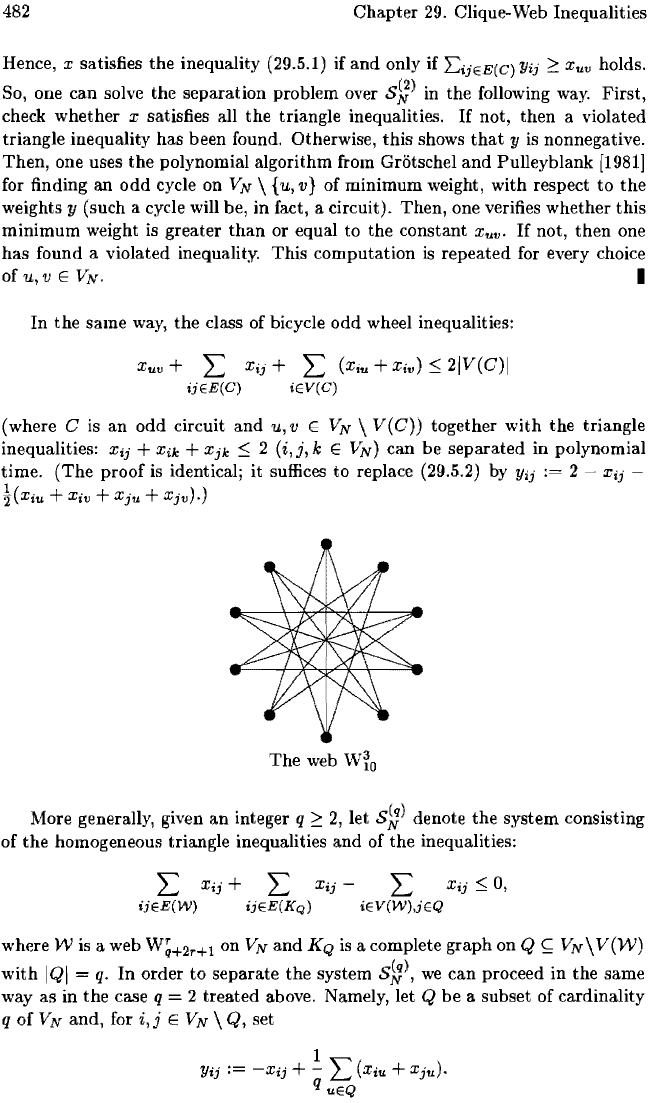
482
Chapter
29. Clique-Web Inequalities
Hence,
x satisfies the inequality (29.5.1) if
and
only if
EijEE(C)
YiJ"
~
x"v
holds.
So, one can solve the separation problem over
S~)
in the following
way.
First,
check whether x satisfies all
the
triangle inequalities.
If
not, then a violated
triangle inequality has been found. Otherwise, this shows
that
Y is nonnegative.
Then,
one uses
the
polynomial algorithm from Grotschel
and
Pulleyblank [1981]
for finding an
odd
cycle on
VN
\ {u, v} of minimum weight, with respect to
the
weights Y (such a cycle will be, in fact, a circuit). Then, one verifies whether this
minimum weight
is
greater
than
or equal to the constant
X"v'
If
not,
then
one
has
found a violated inequality. This computation
is
repeated for every choice
ofu,v
E VN· I
In
the
same
way,
the class of bicycle
odd
wheel inequalities:
X"v
+ L
Xij
+ L
(x;"
+
Xiv)
$
2jV(O)1
ijEE(C)
iEV(C)
(where 0 is an
odd
circuit
and
u,v
E V
N
\
V(O» together
with
the triangle
inequalities:
X;j
+
Xik
+
Xjk
$ 2
(i,j,k
E VN)
can
be separated in polynomial
time. (The
proof
is identical;
it
suffices
to
replace (29.5.2) by
Yij
2
Xij
~(Xiu
+
Xiv
+
Xj"
+
Xjv).)
The
web Wro
More generally, given
an
integer q
~
2,
let
S~)
denote the system consisting
of
the
homogeneous triangle inequalities
and
of
the inequalities:
L
Xij
+ L
Xij
- L
Xij
$ 0,
ijEE(W)
ijEE(KQ)
iEV(W),jEQ
where W is a web
W~+2r+l
on
VN
and
KQ
is
a complete graph on Q
~
VN
\
yeW)
with
IQI
=
q.
In
order to separate the system
S~),
we
can
proceed in the same
way as
in
the case q = 2 treated above. Namely, let Q
be
a subset of cardinality
q
of
VN and, for
i,j
E VN \
Q,
set
Yij
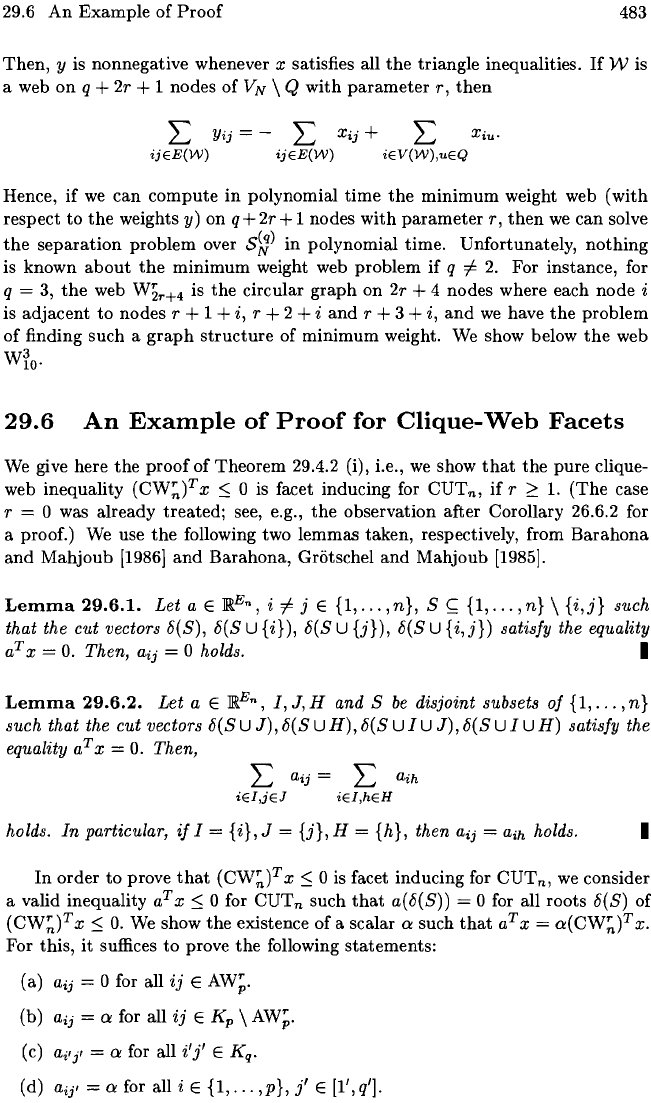
29.6
An
Example
of
Proof
483
Then,
y is nonnegative whenever x satisfies all
the
triangle
inequalities.
If
W is
a web
on
q +
2r
+ 1 nodes
of
VN
\ Q
with
parameter
r,
then
L Yij = - L Xij + L Xiu'
ijEE(W) ijEE(W) iEV(W),uEQ
Hence,
if
we
can
compute
in
polynomial
time
the
minimum
weight web
(with
respect
to
the
weights
y)
on
q +
2r
+ 1 nodes
with
parameter
r,
then
we
can
solve
the
separation
problem
over
S~)
in
polynomial
time.
Unfortunately,
nothing
is
known
about
the
minimum
weight web
problem
if
q
=I-
2. For instance, for
q = 3,
the
web W
2rH
is
the
circular
graph
on
2r
+ 4 nodes where each
node
i
is
adjacent
to
nodes
r + 1 +
i,
r + 2 + i
and
r + 3 + i,
and
we
have
the
problem
of
finding
such
a
graph
structure
of
minimum
weight. We show below
the
web
WYo·
29.6
An
Example
of
Proof
for
Clique-Web
Facets
We give here
the
proof
of
Theorem
29.4.2 (i), i.e.,
we
show
that
the
pure
clique-
web
inequality
(CW~)T
x S 0 is facet
inducing
for
CUT
n
,
if
r
::?:
1.
(The
case
r = 0 was already
treated;
see, e.g.,
the
observation after Corollary 26.6.2 for
a proof.) We use
the
following two
lemmas
taken, respectively, from
Barahona
and
Mahjoub
[1986]
and
Barahona,
Griitschel
and
Mahjoub
[1985].
Lemma
29.6.1.
Let
a E
:IR
En
, i
=I-
j E {I,
...
,
n},
S
~
{I,
...
,
n}
\
{i,j}
such
that
the
cut
vectors
8(S),
8(SU{i}),
8(SU{j}),
8(SU{i,j})
satisfy
the equality
aT
x =
O.
Then,
aij
= 0 holds. I
Lemma
29.6.2.
Let
a E
:IR
En
,
I,
J,
Hand
S
be
disjoint
subsets
of
{I,
...
,
n}
such
that
the
cut
vectors
8(S
U
J),
8(S
U
H),
8(S
U I U
J),
8(S
U I U
H)
satisfy
the
equality
aT
x =
O.
Then,
L aij = L aih
iEI,jEJ iEI,hEH
holds.
In
particular,
if
1=
{i},J
=
{j},H
=
{h},
then
aij = aih holds. I
In
order
to
prove
that
(CW~)T
x S 0 is facet
inducing
for
CUT
n
, we consider
a valid
inequality
aT x S 0 for
CUT
n
such
that
a(
8(S))
= 0 for all
roots
8(S)
of
(CW~)T
x S
O.
We show
the
existence
of
a scalar a such
that
aT
x =
a(CW~)T
x.
For
this,
it
suffices
to
prove
the
following
statements:
(a) aij = 0 for all
ij
E
AW;.
(b) aij = a for all
ij
E Kp \
AW;.
(c) ai'j' = a for all
i'j'
E K
q
•
(d) aij' = a for all i E
{I,
...
,p},
j'
E [l',q'].
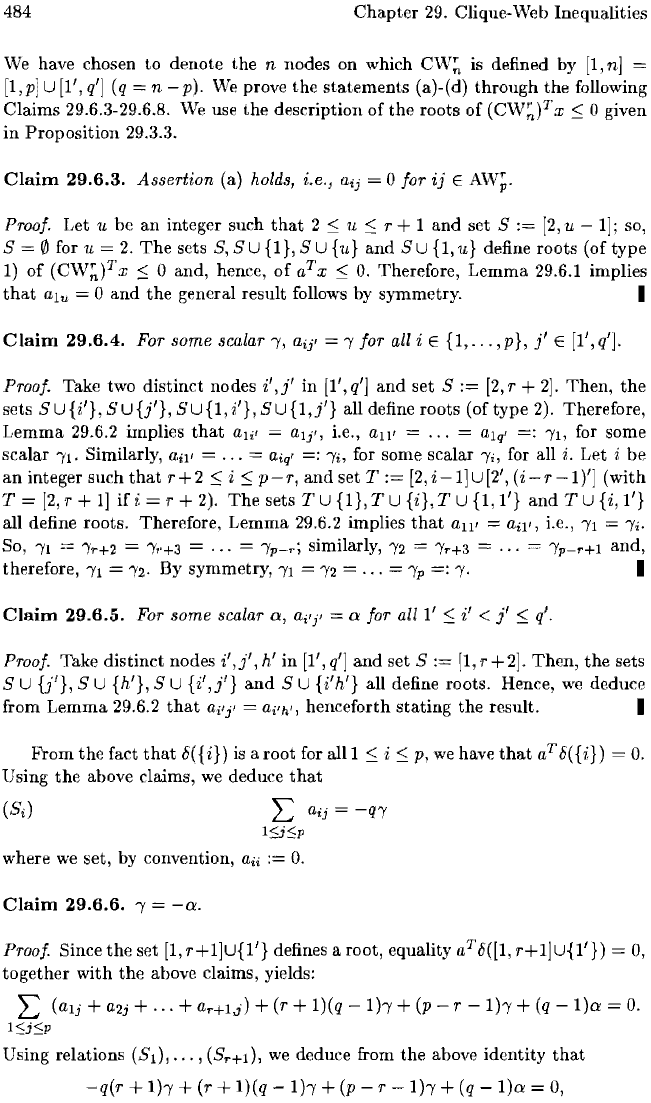
484
Chapter
29.
Clique-Web Inequalities
We
have chosen to denote the n nodes on which
CW~
is defined by [l,n] =
[l,p] U [1',
q']
(q
= n - pl.
We
prove the statements (a)-(d) through the following
Claims 29.6.3-29.6.8.
We
use the description
of
the roots
of
(CW~)T
x::;
0 given
in
Proposition 29.3.3.
Claim
29.6.3.
Assertion
(a)
holds,
aij
0
for
ij
E AW;.
Proof. Let
7L
be
an
integer such
that
2
::;
7L
::;
r + 1
and
set 8
:=
[2,7L
-
1];
so,
8 = 0 for
7L
=
2.
The
sets
8,8
U {I}, 8 U {u} and 8 U {I,
7L}
define roots (of type
1)
of
(CW~)T
x
::;
0 and, hence,
of
aTx
::;
O.
Therefore, Lemma 29.6.1 implies
that
al.., = 0
and
the general result follows by symmetry. I
Claim
29.6.4.
For
some
scalar 'I, aij'
'I
for
all i E
{I,
...
,p},
j'
E
[l',q'j.
Proof. Take two distinct nodes
i',j'
in
[l',q']
and
set
8:=
[2,r +
2].
Then,
the
sets
8u
{i'}, 8 u
{j'},
8 U {I,
ill,
8 U
{1,j'}
all define roots (of type 2). Therefore,
Lemma
29.6.2 implies
that
alii =
alj',
i.e.,
alii
=
...
=
al
q
'
=:
'11,
for some
scalar
'11.
Similarly,
ail'
...
=
aiq'
=:
'Ii, for some scalar 'Ii, for all i. Let i
be
an
integer such
that
r+2
::;
i
::;
p-r,
and set T
:=
[2,
i
-1]
U[2', (i
-r
-1)']
(with
T
[2,r+I]
ifi
r+2).
ThesetsTU{I},TU{i},TU{l,l'}
andTU{i,I'}
all define roots. Therefore, Lemma 29.6.2 implies
that
all
'
=
ail',
i.e.,
'11
'Ii.
So,
'11
'11'+2
'11'+3
...
=
'1p-1';
similarly,
'12
=
'11'+3
=
...
=
'1p-r+l
and,
therefore,
'11
'12.
By symmetry, 'II =
'12
=
...
=
'1p
=:
'I. I
Claim
29.6.5.
For
some
scalar
a,
ai'j' = a for
aliI'
::;
i'
<
j'
::;
q'.
Proof.
Take distinct nodes
i',j',
h'
in
[I',
q']
and
set 8
:=
[1,
r+2].
Then, the sets
8 U {j'}, 8 U
{h'},
8 U {if,
j'}
and
8 U {i
'
h'}
all define roots. Hence,
we
deduce
from Lemma 29.6.2
that
ai')'
=
ai'
hi
, henceforth stating the result. I
F'rom the fact
that
8(
{i})
is
a root for
aliI::;
i
::;
p,
we
have
that
aT
8(
{i})
O.
Using
the
above claims,
we
deduce
that
E
aij
=
_qAt
l:5j:5p
where
we
set, by convention, aii
:=
O.
Claim
29.6.6.
'I
=
-a.
Proof. Since
the
set
[1,
r+
I]U{I'} defines a root, equality aT 8([1,
r+1]U{I'})
= 0,
together with the above claims, yields:
E
(a1j+a2j+
...
+a
1'
+l,j)+(r+I)(q
1h+(p
r-1h+(q-l)oo=0.
l:5j:5p
Using relations (Sd,
...
, (8
r
+1),
we
deduce from the above identity
that
-q(r+1h+(r+1)(q
lh+(p
r
1h+(q
1)00=0,
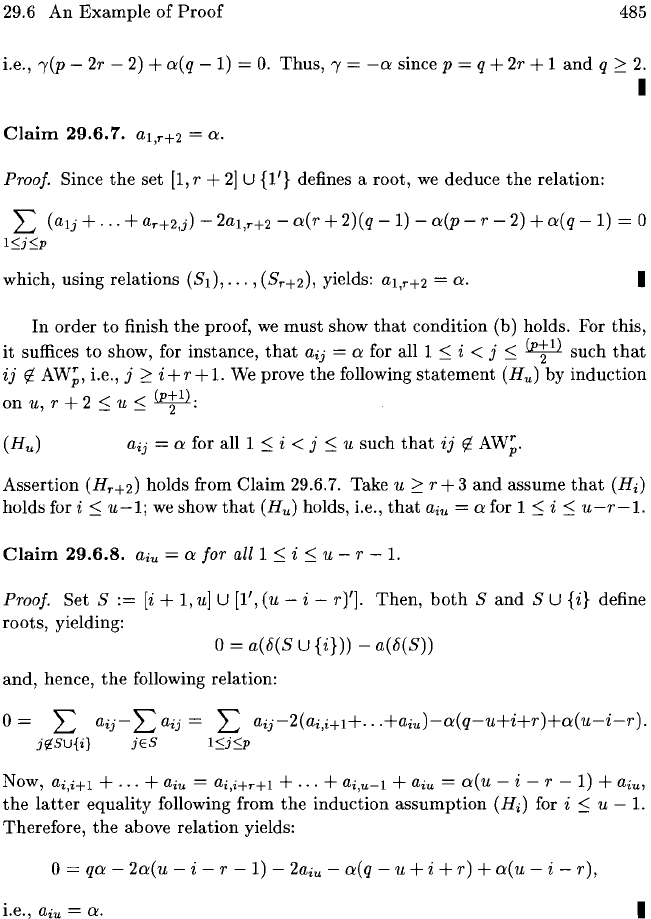
29.6
An
Example
of
Proof
485
i.e.,
ry(p
-
2r
-
2)
+
a(q
-
1)
=
O.
Thus,
ry
=
-a
since p = q +
2r
+ 1
and
q
2:
2.
I
Claim
29.6.7.
a1,r+2
=
a.
Proof. Since
the
set
[1,
r +
2]
U {I'} defines a root,
we
deduce
the
relation:
L
(alj
+ ... + a
r
+2,j) - 2a1,r+2 -
a(r
+
2)(q
-
1)
-
a(p
- r -
2)
+
a(q
-
1)
= 0
l";j";p
which, using relations
(Sl),'"
,(Sr+2),
yields:
a1,r+2
=
a.
I
In
order
to
finish
the
proof,
we
must
show
that
condition (b) holds. For this,
it
suffices
to
show, for instance,
that
aij
= a for all 1
::::;
i < j
::::;
(Pil)
such
that
ij
!f-
AW;,
i.e., j
2:
i+r+1.
We prove
the
following
statement
(Hu)
by
induction
on
u r + 2 < u <
(pH):
, - - 2
aij
= a for all 1
::::;
i < j
::::;
u such
that
ij
!f-
AW;.
Assertion
(H
r
+
2
)
holds from
Claim
29.6.7. Take u
2:
r + 3
and
assume
that
(Hi)
holds for i
::::;
u-l;
we
show
that
(Hu)
holds, i.e.,
that
aiu = a for
1::::;
i
::::;
'u-r-l.
Claim
29.6.8.
aiu = a
for
all 1
::::;
i
::::;
u - r -
1.
Proof. Set S
:=
[i
+ 1,
u]
U
[I',
(u
- i - rl'l.
Then,
both
Sand
S U {i} define
roots, yielding:
0=
a(8(S
U {i})) -
a(8(S))
and,
hence,
the
following relation:
0=
L
aij-
L aij = L
aij-2(ai,i+1+'
..
+aiu)-a(q-u+i+r)+a(u-i-r).
jg'SU{i}
jES
l";j";p
Now, ai,i+1 + ... + aiu = ai,i+r+1 + ... + ai,u-1 + aiu =
a(u
- i - r -
1)
+ aiu,
the
latter
equality following from
the
induction
assumption
(Hi)
for i
::::;
u -
1.
Therefore,
the
above relation yields:
0=
qa
-
2a(u
- i - r -
1)
- 2aiu -
a(q
- u + i +
r)
+
a(u
- i -
r),
i.e., aiu =
a.
I
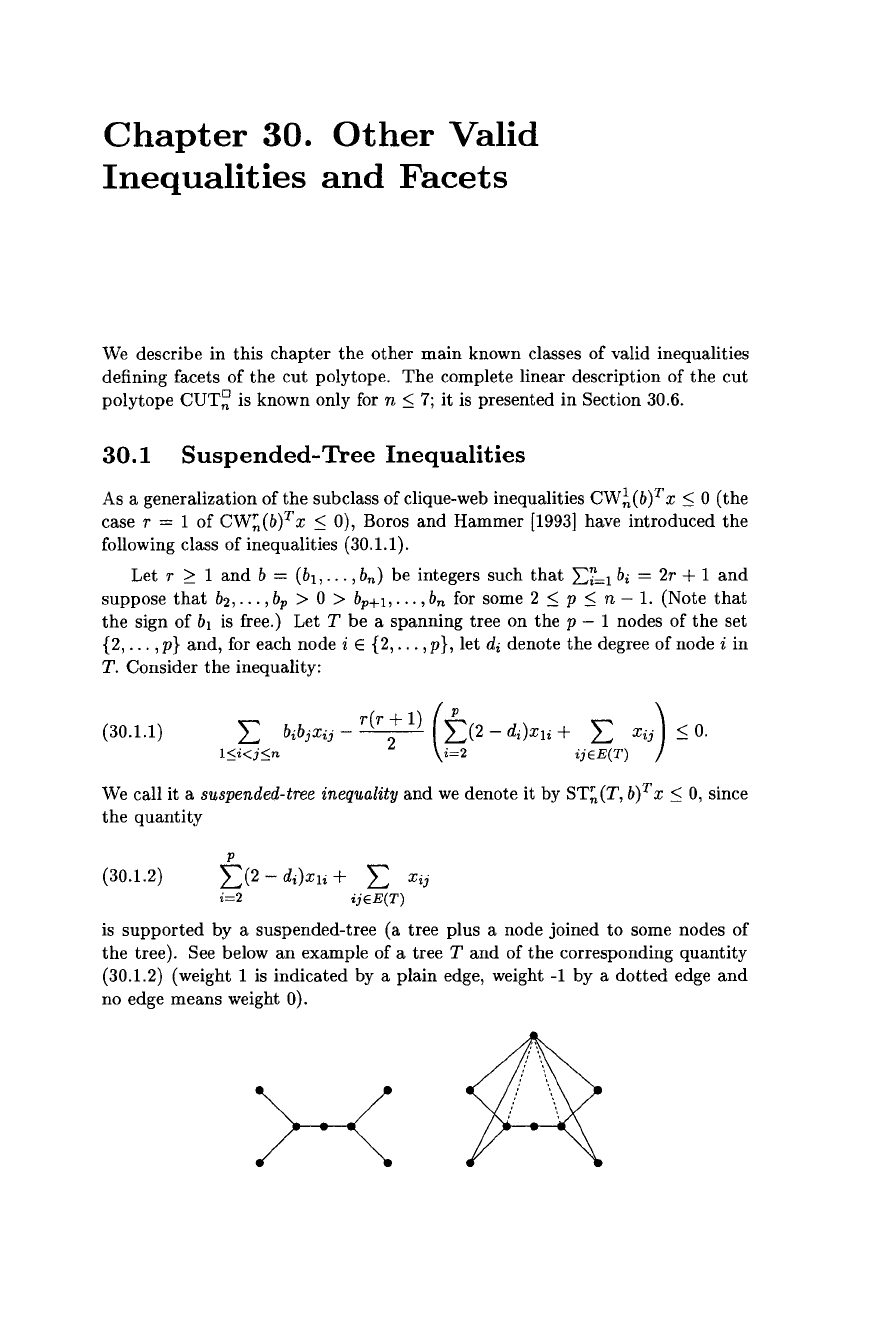
M.M. Deza, M. Laurent, Geometry of Cuts and Metrics, Algorithms and Combinatorics 15,
DOI 10.1007/978-3-642-04295-9_30, © Springer-Verlag Berlin Heidelberg 2010
Chapter
30.
Other
Valid
Inequalities
and
Facets
We describe
in
this
chapter
the
other
main
known classes
of
valid inequalities
defining facets
of
the
cut
polytope.
The
complete linear description
of
the
cut
polytope
CUT~
is known only for n
:::;
7;
it
is presented
in
Section 30.6.
30.1
Suspended-
Tree
Inequalities
As a generalization
of
the
subclass
of
clique-web inequalities
CW;,(b)T
x
:::;
0
(the
case r = 1
of
CW~(b)T
x
:::;
0), Boros
and
Hammer
[1993]
have
introduced
the
following class
of
inequalities (30.1.1).
Let
r
2:
1
and
b =
(b
1
,
.•.
, b
n
) be integers such
that
2:i=l
b
i
= 2r + 1
and
suppose
that
b
2
,
...
, b
p
> 0 >
bp+b""
b
n
for some 2
:::;
P
:::;
n -
1.
(Note
that
the
sign
of
b
1
is
free.) Let T
be
a spanning tree on
the
p - 1 nodes
of
the
set
{2,
...
,p}
and,
for each node i E {2,
...
,p}, let d
i
denote
the
degree
of
node i
in
T. Consider
the
inequality:
(30.1.1)
'"
r(r
+ 1)
(~
"')
~
bibjXij
- 2
~(2
-
di)Xli
+
~
Xij
:::;
O.
l::;i<j::;n i=2
ijEE(T)
We call it a suspended-tree inequality
and
we
denote it by
ST~(T,
bf
x
:::;
0,
since
the
quantity
p
(30.1.2)
L(2
-
di)Xli
+ L
Xij
i=2
ijEE(T)
is
supported
by a suspended-tree (a tree plus a node joined
to
some nodes
of
the
tree). See below
an
example
of
a tree T
and
of
the
corresponding
quantity
(30.1.2) (weight 1 is indicated by a
plain
edge, weight
-1
by a
dotted
edge
and
no edge
means
weight 0).
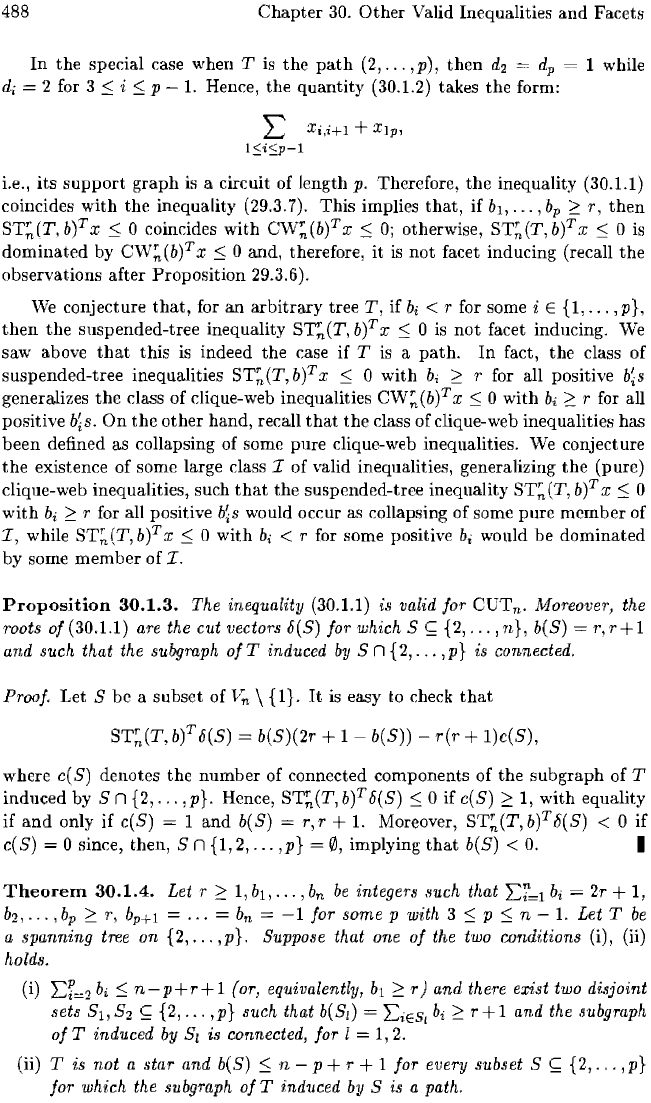
488
Chapter
30.
Other
Valid Inequalities
and
Facets
In
the special case when T
is
the
path
(2,
...
,p),
then
d
2
d
p
1 while
di
= 2 for 3
.::;
'i
.::;
p
1.
Hence, the
quantity
(30.1.2) takes
the
form:
I:
Xi,iH
+
Xl
p ,
1:s;i5p-l
i.e., its
support
graph
is a circuit of length p. Therefore,
the
inequality (30.1.1)
coincides
with
the
inequality (29.3.7).
This
implies
that,
if
bl, .
..
,b
p
~
r,
then
ST~
(T,
b?
x
.::;
0 coincides
with
CW~
(b)T x
.::;
0;
otherwise,
ST~
(T, b)T x
.::;
0
is
dominated
by
CW~(b)T
x 0 and, therefore,
it
is
not
facet inducing (recall
the
observations after Proposition 29.3.6).
We
conjecture
that,
for
an
arbitrary
tree
T,
if
bi
< r for some i E {I,
..
. ,p},
then
the
suspended-tree inequality
STn(T,
b)T x
.::;
0
is
not
facet inducing.
We
saw above
that
this
is
indeed the case
if
T
is
a
path.
In
fact, the class
of
suspended-tree inequalities
ST~(T,b)Tx
.::;
0 with
bi
~
r for all positive
b;s
generalizes
the
class of clique-web inequalities
CW~(b?
x.::;
0 with
bi
2:
r for all
positive
b;s.
On
the
other
hand, recall
that
the
class of clique-web inequalities has
been
defined as collapsing of some pure clique-web inequalities.
'vVe
conjecture
the
existence of some large class
'I
of valid inequalities, generalizing
the
(pure)
clique-web inequalities, such
that
the suspended-tree inequality
ST~
(T, b)T x
.::;
0
with
bi
~
r for all positive
b;s
would occur
as
collapsing of some pure
member
of
while
ST~
(T, b)T x
.::;
0
with
b
i
< r for some positive
bi
would
be
dominated
by some
member
of 'I.
Proposition
30.1.3.
The inequality (30.1.1) is valid for
CUT
n
.
Moreover, the
roots
of
(30.1.1) are the cut vectors
6(S)
for which S
<;;;
{2,
...
,n},
b(S)
=
r,r+l
and such that the subgraph
of
T induced
by
S n {2,
...
,p}
is connected.
Proof.
Let S
be
a subset
of
Vn
\ {I}.
It
is easy to check
that
ST~(T,
b?
6(S)
=
b(S)(2r
+ 1 b(S»
r(r
+
l)c(S),
where
c(S)
denotes the
number
of connected components
of
the subgraph of T
induced by S n {2,
...
, p}. Hence,
ST~
(T,
b?
6(S)
.::;
0 if
c(
S)
~
1,
with equality
if
and
only if
c(S)
= 1
and
b(S) =
r,r
+ 1. Moreover,
ST~(T,b)T8(S)
< 0
if
c(S)
0 since, then, S n
{I,
2,
...
,p}
=
0,
implying
that
b(S) <
o.
I
Theorem
30.1.4.
Let r ?
1,
bl,""
b
n
be
integers such that
bi
2r +
I,
b2,""
b
p
~
r,
bp+l
...
= b
n
=
-1
for some p with 3
.::;
p
.::;
11.
-
1.
Let T
be
a spanning tree on
{2,
...
,pl.
Suppose that one
of
the two conditions (i),
Oi)
holds.
(i)
bi
.::;
11.
- P + r + 1 (or, equivalently, b
1
~
r)
and there exist two disjoint
sets
S2
{2,
...
)
p}
such that
b(
SI)
=
I:iES,
b
i
~
r + 1
and
the subgraph
of
T induced by
SI
is connected, for l =
1,2.
(ii) T is
not
a
star
and b(S)
.::;
11.
- P + r + 1
for
every subset S
<;;;
{2,
...
,p}
for which the subgraph
of
T induced by S is a path.
